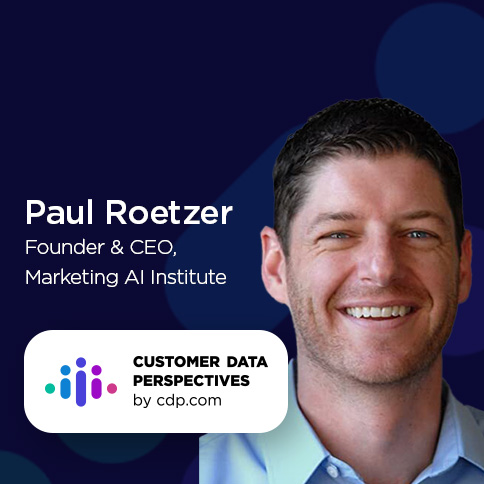Paul Roetzer, Founder & CEO of the Marketing Artificial Intelligence Institute, shared a provocative statement as my guest for Episode Seven of the Customer Data Perspectives. “Personalization is kind of like the holy grail,” he said, speaking about this all-important marketing strategy long sought by B2C and B2B marketers.
Paul’s been educating marketers on the importance of leaving rule-based marketing tactics behind as legacy practices and shifting to “next-gen” approaches based on machine learning, natural language processing, and other forms of artificial intelligence. In his new book, “Marketing Artificial Intelligence,” he recommends best practices and tools for applying AI in sales, customer service, and several digital marketing practices, including search engine optimization, email marketing, and social media marketing.
Content Marketers Risk Falling Behind Without AI
In the podcast, Paul explains how he got into AI, starting from his background in journalism, content marketing, and running an agency. “We needed to generate 500 new leads a quarter or increase our audience by 20 percent,” he says. “As marketers, we try to predict what action to take to generate an outcome, but by 2011- 12, humans couldn’t process all the choices and the thousands of ways you could spend marketing dollars. My interest in AI was very focused. Can it help me build strategies and help me allocate my budget?”
Paul explains in detail why content marketers must embrace AI before it’s too late, a statement he shares in the book. “We all create content, and a lot of brands these days are built in essence as media companies,” says Paul, implying that the demand creates the opportunity for AI and tech investments. Leading content marketers can develop a competitive advantange by using AI-enabled technologies to scale content creation, perform A/Z testing, personalize messaging, and excel at other capabilities that leverage customer data.
Marketers can start with basic tools like Grammarly and basic natuaral language processing built into office tools, but that’s not good enough to be competitive today. “If you are not experimenting with language generation tools, like Copy.ai, Jasper, HyperWrite, or other GPT3-based tools, then you’re probably falling behind,” he says.
Personalizing Experiences Requires Experimenting and Improving Customer Data
But it’s Paul’s statement on personalization that I find most intriguing because we’ve been talking about personalizing websites, mobile apps, advertisements, and customer experiences for what – two decades now? Anything that’s not static, a one-size-fits-all experience might be labeled as personalized. Conversely, we want to ensure that personalization doesn’t step over privacy boundaries and into the creepy, biased, inappropriate, or illegal.
“Many brands, especially on the B2B side, think personalization is name and company,” Paul says. “B2C brands you assume would have the ability to do personalization at a better level, but they’re not doing it as well as they should be.” We all have stories of failed or retargeting breakdowns, and Paul shares a classic example during the podcast.
So Paul provides a realistic target for personalization and says marketers should “truly understand the difference between your intent and my intent based on our click history or our opens of the newsletters.” I would add social media activity, non-actions (like not opening an email), and any other events we capture and centralize in a customer data profile.
So why is it so hard and long for B2C and B2B marketers to deliver personalized experiences? Paul answers, “It’s hard because the average enterprise has some hundred 101-120 marketing and sales tech solutions. So getting all those things talking to each other to drive this personalization is challenging.”
I spoke about these challenges with previous guests of Customer Data Perspectives, including Scott Brinker’s recommendations on integrations and David Raab’s recommendations on how customer data profile (CDP) platforms are solutions.
CDPs and the Journey to Personalized Experiences
I agree with Paul when he says, “Going from zero to a hundred is just not going to happen in most organizations” when implementing personalization. In the podcast, he shares some simple ways to get started on the front-end user experience, from scheduling emails to selecting subject titles.
But personalization also requires collecting more information about the customer, building up their profile, integrating data across their journeys, and enriching with third-party data. I believe implementing a CDP in iterations is the key investment to incrementally improve the data and enable machine learning to support it.
Personalization must also be compliant, and Paul and I leave recommendations for CMOs on what steps they should consider supporting rapid experimentation while avoiding privacy risks. Successful customer-facing AI and machine learning programs require collaboration between marketers, data scientists, and privacy officers, especially when scaling successful experiments.
Accelerating from Personalization to the Future of AI
Marketers can no longer hold off investing in a CDP, improving data quality, integrating marketing tools, and experimenting with AI. In the podcast, Paul shares two potential futures of AI, one involving artificial general intelligence (AGI), where AI algorithms have greater context and human-like cognition, and another centered on AI enhancing human creativity. Both futures are plausible, but marketers holding onto last-gen tactics will lack key data and analytics capabilities needed to compete in a world powered by machine learning and artificial intelligence.



